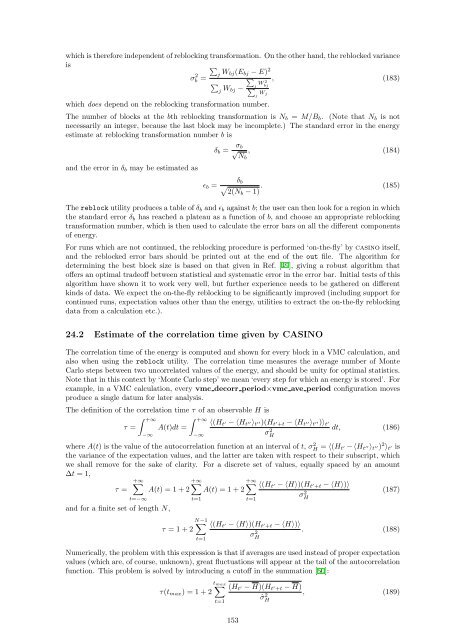CASINO manual - Theory of Condensed Matter
CASINO manual - Theory of Condensed Matter
CASINO manual - Theory of Condensed Matter
You also want an ePaper? Increase the reach of your titles
YUMPU automatically turns print PDFs into web optimized ePapers that Google loves.
which is therefore independent <strong>of</strong> reblocking transformation. On the other hand, the reblocked variance<br />
is<br />
∑j<br />
σb 2 =<br />
W bj(E bj − E) 2<br />
∑ , (183)<br />
∑<br />
j W bj − ∑ W 2 j bj<br />
j Wj<br />
which does depend on the reblocking transformation number.<br />
The number <strong>of</strong> blocks at the bth reblocking transformation is N b = M/B b . (Note that N b is not<br />
necessarily an integer, because the last block may be incomplete.) The standard error in the energy<br />
estimate at reblocking transformation number b is<br />
δ b =<br />
σ b<br />
√ , (184)<br />
Nb<br />
and the error in δ b may be estimated as<br />
ɛ b =<br />
δ b<br />
√<br />
2(Nb − 1) . (185)<br />
The reblock utility produces a table <strong>of</strong> δ b and ɛ b against b; the user can then look for a region in which<br />
the standard error δ b has reached a plateau as a function <strong>of</strong> b, and choose an appropriate reblocking<br />
transformation number, which is then used to calculate the error bars on all the different components<br />
<strong>of</strong> energy.<br />
For runs which are not continued, the reblocking procedure is performed ‘on-the-fly’ by casino itself,<br />
and the reblocked error bars should be printed out at the end <strong>of</strong> the out file. The algorithm for<br />
determining the best block size is based on that given in Ref. [49], giving a robust algorithm that<br />
<strong>of</strong>fers an optimal trade<strong>of</strong>f between statistical and systematic error in the error bar. Initial tests <strong>of</strong> this<br />
algorithm have shown it to work very well, but further experience needs to be gathered on different<br />
kinds <strong>of</strong> data. We expect the on-the-fly reblocking to be significantly improved (including support for<br />
continued runs, expectation values other than the energy, utilities to extract the on-the-fly reblocking<br />
data from a calculation etc.).<br />
24.2 Estimate <strong>of</strong> the correlation time given by <strong>CASINO</strong><br />
The correlation time <strong>of</strong> the energy is computed and shown for every block in a VMC calculation, and<br />
also when using the reblock utility. The correlation time measures the average number <strong>of</strong> Monte<br />
Carlo steps between two uncorrelated values <strong>of</strong> the energy, and should be unity for optimal statistics.<br />
Note that in this context by ‘Monte Carlo step’ we mean ‘every step for which an energy is stored’. For<br />
example, in a VMC calculation, every vmc decorr period×vmc ave period configuration moves<br />
produce a single datum for later analysis.<br />
The definition <strong>of</strong> the correlation time τ <strong>of</strong> an observable H is<br />
τ =<br />
∫ +∞<br />
t=−∞<br />
−∞<br />
A(t)dt =<br />
∫ +∞<br />
−∞<br />
〈(H t ′ − 〈H t ′′〉 t ′′)(H t ′ +t − 〈H t ′′〉 t ′′)〉 t ′<br />
σ 2 H<br />
dt, (186)<br />
where A(t) is the value <strong>of</strong> the autocorrelation function at an interval <strong>of</strong> t, σH 2 = 〈(H t ′ − 〈H t ′′〉 t ′′)2 〉 t ′ is<br />
the variance <strong>of</strong> the expectation values, and the latter are taken with respect to their subscript, which<br />
we shall remove for the sake <strong>of</strong> clarity. For a discrete set <strong>of</strong> values, equally spaced by an amount<br />
∆t = 1,<br />
+∞∑<br />
+∞∑<br />
+∞∑ 〈(H t ′ − 〈H〉)(H t<br />
τ = A(t) = 1 + 2 A(t) = 1 + 2<br />
′ +t − 〈H〉)〉<br />
σH<br />
2 (187)<br />
and for a finite set <strong>of</strong> length N,<br />
t=1<br />
N−1<br />
∑<br />
τ = 1 + 2<br />
t=1<br />
t=1<br />
〈(H t ′ − 〈H〉)(H t′ +t − 〈H〉)〉<br />
σH<br />
2 . (188)<br />
Numerically, the problem with this expression is that if averages are used instead <strong>of</strong> proper expectation<br />
values (which are, <strong>of</strong> course, unknown), great fluctuations will appear at the tail <strong>of</strong> the autocorrelation<br />
function. This problem is solved by introducing a cut<strong>of</strong>f in the summation [50]:<br />
t∑<br />
max<br />
τ(t max ) = 1 + 2<br />
t=1<br />
(H t ′ − H)(H t′ +t − H)<br />
ˆσ<br />
H<br />
2 , (189)<br />
153

















